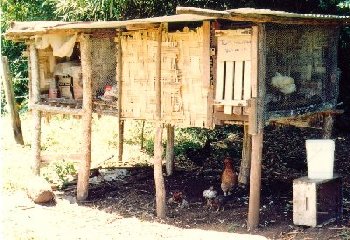John's Beekeeping Notebook
My Other Peace Corps Projects
Peace Corps gave me the opportunity to act on ideas outside of my initial assignment and develop them. Some projects were successful and I had a good time trying all of them!
I quickly learned that convincing people to try new ideas can be very difficult, and that doing something myself was often the best way to get projects started.
Chickens
Chicken mortality was very high among young chicks due to hawks and mongoose predation. I built a chicken house to provide protection to the chicks until they were old enough to sleep in the trees.
The village chickens were scrawny but well-adapted to free-ranging. I introduced some fast-growing Cornish-Rock meat birds to the village, but found the hens to be poor mothers. The good news was that crosses between a Cornish-Rock rooster and village hen produced chicks that were faster growing than the village birds. It also had more meat and were still good setters and mothers.

Following the success of my chicken house, the local youth group followed with their own chicken coop.
Melons
Growing watermelons in a sugar cane field seemed similar to growing pumpkins in a corn field, so I tried it. It worked, but I learned that the young sprouts needed protection from rodents! Unfortunately, watermelons are heavy and hard to bring to market.
Gravity-fed Water Supply

A reliable clean water supply is not taken for granted in rural Fiji. Pierre (the light-skinned guy below) lived a few hours away in Rakiraki and was one of the nearest volunteers to me for most of my service. He and I worked together on a gravity-fed water supply project for the nearby village of Nabalabala, Ra.
We built this tank to store spring water for the village in the valley.

This water tank and delivery project was made possible by a generous donation from Beattie Elementary School in Fort Collins, Colorado, through the Peace Corps Partnership Program. I enjoyed corresponding with them during the project. Thank you, Fort Collins, Colorado!!
Toilets
The Fiji Health Department encouraged changing the usual "hole in the ground" out-houses to ones with toilets that had a water seal. The water seal prevented critters from entering and leaving the pit and protected one's butt!
The toilets were flushed with a can of water from the tap or rain barrel.
For a nominal cost, we bought plastic toilet traps, and borrowed molds to build the concrete toilets and base. A few volunteers from my village built about twenty toilets. At left, my Turaga ni Koro (mayor) takes pride in our concrete handicrafts.
Back to beekeeping ....
[ Fiji Beekeeping ] [ Ukraine Beekeeping ] [ Moldova Beekeeping ]